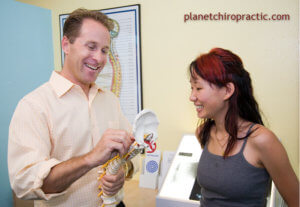by Dr. Adam Tanase, Upper Cervical Chiropractor
The word semantics is defined, “The branch of linguistics and logic concerned with meaning.”
 As principled Chiropractors, you’ve participated in many debates and discussions regarding semantics within our profession. The most common is the difference between using the words “adjustment” and “manipulation.” Knowing that manipulate means “to control or influence cleverly, unfairly, or unscrupulously” certainly steers us away from using the word to describe anything about our beloved craft.
As principled Chiropractors, you’ve participated in many debates and discussions regarding semantics within our profession. The most common is the difference between using the words “adjustment” and “manipulation.” Knowing that manipulate means “to control or influence cleverly, unfairly, or unscrupulously” certainly steers us away from using the word to describe anything about our beloved craft.
Then there’s the semantics of the word “subluxation” versus that of “segmental dysfunction” or “fixation.” I, for one, argued endlessly in chiropractic school to defend my right to use the word subluxation in clinic notes.
Doctors even go as far as breaking down components of our lexicon to make educational points. Sub- means “less than;” -luxation means “dislocation.” Thus, subluxation implies less than a complete dislocation.
What about the word, “dis-ease?” We know that there is a profound difference between disease and dis-ease in that the process of dis-ease leads to disease. If you thought these words were one in the same, such proves the importance of semantics.
While attending a chiropractic summit recently, a number of doctors and students vocally stated that chiropractors remove subluxation. But if we’ve always been careful with use of the words adjustment, subluxation, and dis-ease, why are so many doctors careless in using the word “remove” to describe what our profession does once these subluxations are detected?
If we look at this word from the perspective of our patients, we’re likened to surgeons who routinely remove wisdom teeth, polyps and gallbladders. Does your adjusting room have any scalpels, cauterizing tools, sutures or gauze?
Surgical removal is permanent. My wisdom teeth were removed when I was 19; last time I checked, they hadn’t grown back. So if you are in fact “removing” a subluxation, you can only do it once, and if your patients keep coming back to have the same subluxation “removed,” it’s time to admit that you just plain suck at surgery.
What if we separate the word into its components? Re- means to “do again;” move means to “change position.” So I ask you, to what position do you keep moving the subluxation? One can move and re-move a subluxation over and over again, but what’s the point?
Doctors who move and re-move subluxations have perpetually subluxated patients. Are any of your patients ever not subluxated? Do they ever leave your clinic without receiving an adjustment? If all you’re ever doing is re-moving subluxations to different positions, then no – your patients are not getting well.
Principled Chiropractors correct subluxation. Correcting something means, “adjust to function accurately or in accordance with standard.” In other words, to make normal.
You’re definitely not removing subluxations, but you could very well be re-moving them. Doctors who do not have a measurable criteria to determine the presence or absence of subluxation are merely re-moving subluxations around and around. If you think you’re correcting a subluxation because it made a noise, you’re sadly mistaken.
I hate to be the bearer of bad news, but unless you have divine power, your hands are not capable of detecting subluxation any more accurately than your hands are capable of feeling words travel through a telephone cord. It just doesn’t happen.
BJ Palmer was the most accomplished and successful chiropractor in the history of our profession. He used para-spinal thermography before and after every adjustment. He couldn’t palpate nerve interference, and it’s a safe bet that you can’t either. Some docs use leg checks and anatometers. Find a reputable system of analysis that works for you and use it – every visit – not every 12th.
We need to be 100% certain of two things. One, that an adjustment is necessary. After all, an adjustment is only as good as its timing. And two, that we actually did what the patient is paying us to do – correct the subluxation.
Now here is where you’ll either love me or hate me. But since I’m not here to make friends, I’m laying it all out there for you to read. It is my belief, and BJ would certainly agree, that it is categorically irresponsible, unethical, illogical and unintelligent for any doctor to assume that because he or she heard an audible sound after pounding on a high spot or fixation within the spine that they corrected a subluxation.
That line of thinking has demonstrated to be unreliable, obsolete and consequently abandoned in 1924 after the advent of the neurocalometer.
Friends, don’t shoot the messenger, but the reliability of palpation to detect vertebral subluxation died over 80 years ago.
Therefore, it is our responsibility as defenders of this great profession to use a scientific, accurate and duplicable method of subluxation correction. Palpation is no such method. Period.
The reason members of the general public ask you, “Can you crack my back” when they first learn what you do is because so many doctors within our profession devalue chiropractic. They cheapen it to such an extent that they’re willing to “adjust” (and I use that term loosely to describe the crude manipulations they provide in this instance) people at bars, sporting events, family functions and even in parking lots, without exam or x-ray.
Imagine being at your next Rotary Club luncheon when the guest speaker for the afternoon is Dr. Jones – General Surgeon. After his short presentation, Joe Public asks him, “Doc, I’ve got gallstones, can you lay me down right here, remove this pesky thing, and stitch me back up?”
Or what about Dr. Smith – Family Dentist? Joe Public approaches Dr. Smith in the grocery store holding his jaw, “Doc, my tooth hurts!” Dr. Smith happens to have a handkerchief and pocket knife in his pants pocket – Do you think he’s going to extract the tooth right there?
It’s common sense to all of us – this would never happen. Wise Dr. Jones & Dr. Smith respect what they do enough to make people actually schedule appointments. Chiropractors should be no different!
I hold this profession in the highest regard; I value the adjustment, and not as a “natural” pain reliever or some fancy massage. I see it as something that has the ability to save lives! And with the gift that we’ve been given – the gift of correcting subluxations – we must value it! Respect it! Honor it! And use it ethically to help the sick people of this world to get well.
BJ said, “We Chiropractors work with the subtle substance of the soul. We release the imprisoned impulse — the tiny rivulet of force — that emanates from the mind and flows over the nerves to cells and stirs them into life.” But somewhere along the way, members of our profession translated that to mean, “We crack backs, pop necks and alleviate low back pain because people tell us it makes them feel good.”
Friends, if audible noises and the absence of pain are your only means of determining whether or not you helped a patient, then may God rest your soul because your ChiropracTIC flame has been extinguished (or was never lit to begin with).
You have the prestigious honor of helping sick people get well. What an amazingly respectable calling! To do that, you must first value what you do with such high regard that it must be done properly – not half-ass!
Detect the subluxation with a reliable system of analysis. Correct the subluxation with accuracy and precision. Do it with such remarkable skill that the intent behind what you’re doing is unshakable. There will be no doubt in your mind that once delivered, your adjustment will “release the imprisoned impulse” that can get sick people well!
It’s time to start holding yourself accountable to a higher standard.
You are a professional Chiropractor.
Dr. Tanase is an Upper Cervical Chiropractor from St. Louis, MO.





Comments are closed for this article!